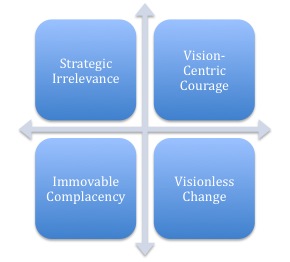We live in an unprecedented time in history where opportunities are everywhere. And because opportunity abounds (often hidden as problems), leaders in particular wrestle with which opportunities are the best opportunities. How do you choose?
Opportunity typically works in tandem with two forces: Focus and Risk. Without focus, we tend to pursue every opportunity. But without a willingness to risk, we tend to avoid every opportunity. The following “Opportunity Matrix” illustrates four opportunity quadrants and what happens when focus and risk are at play.
 Immovable Complacency (Low Focus/Low Risk) – This type of opportunity really isn’t an opportunity at all. It’s like a giant magnet preventing any forward traction. Churches in this corner are typically disengaged, unmotivated, and on a comfortable plateau, or worse, coasting in a downward direction. Their lack of focus has made them complacent and their low risk tolerance has made them immovable.
Immovable Complacency (Low Focus/Low Risk) – This type of opportunity really isn’t an opportunity at all. It’s like a giant magnet preventing any forward traction. Churches in this corner are typically disengaged, unmotivated, and on a comfortable plateau, or worse, coasting in a downward direction. Their lack of focus has made them complacent and their low risk tolerance has made them immovable.
Strategic Irrelevance (High Focus/Low Risk) – Leaders and churches in this quadrant are highly focused and deeply committed. The problem is, they’re highly focused and deeply committed to pursuing “safe” opportunities that keep them closely tied to outdated and irrelevant traditions. They resist change. These churches have tunnel vision…they’re so focused on what they are doing that they can’t see what they could do…and so they miss their greatest opportunities. They’re so married to their strategies that they’ve become strategically irrelevant.
Visionless Change (Low Focus/High Risk) – This corner of the quadrant is a bit of a paradox. The idea of taking risks while lacking focus doesn’t seem to fit together. This reality is usually nothing more than short-term infatuation. It could easily be described as vision-jumping, splash-in-the-pan leadership, or addiction to the latest fad. The problem is that nothing sticks. Churches in this scenario experience vision whiplash. You could say their infatuation with change overrides their clarity and commitment to vision, ultimately producing a high-risk, low-focus environment of “vision-less change.” They change for the sake of change without any understand of their True North. Leaders and volunteers are often worn out in this environment.
Vision-Centric Courage (High Focus/High Risk) – The top right box in the opportunity matrix is where high levels of focus intersect with high levels of risk with the greatest potential to produce high levels of impact. This doesn’t mean the risk is unwise or untested. Precisely the opposite. Leaders and churches in this corner have defined a clear vision and courageously execute tested, calculated, risk-taking strategies to see that vision fulfilled. Courage is only needed in the face of fear, and thus courage implies change. When the change is vision-centric, it keeps the organization on track.
So where are you (and your church) in the Opportunity Matrix? And what does it take to move to the top right quadrant? Consider the following as a launching point to embrace “Vision-Centric Courage”:
1. Moving from “Immovable Complacency” – Cultivate a learning posture while creating an appropriate sense of urgency. Most teams get stuck when they stop listening and learning. How can you expose your team to new voices, quality books, and fresh strategies. Do you need to acquire coaching or consulting? Before you can unlock the church, you have to unlock your leadership. And to get a sense of urgency in play, consider reading John Kotter’s book, A Sense of Urgency. Here’s a post I shared from Kotter’s book on urgency.
2. Moving from “Strategic Irrelevance” – Build momentum with small wins. You don’t have to turn the entire ship overnight, but you do need to start turning the rudder and introducing change. Small wins will give you the momentum, confidence, and trust to go after bigger opportunities.
3. Moving from “Visionless Change” – Solidify your vision and adopt the right perspective of opportunities. Solidifying your vision will be the toughest step, but it is essential if you want to keep your team energized and focused. Once you solidify your vision, you need to take a new attitude toward opportunities. Andy Stanley framed it well when he said, “Opportunity does not equal obligation.” Let this statement set you free from your infatuation with the latest, greatest idea.
Question: Which quadrant are you (and your church) in? What’s your next step?






